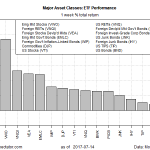Many of our readers might remember the late 80s. There were hundreds of movies, songs and books about the inevitable Japanese economic invasion. The ones of you that did not live that period can see that it did not happen.
Why? Because the Japanese growth miracle was built on a massive debt bubble and, once it burst, the country fell into stagnation for the better part of two decades. It still has not recovered.

China presents many similarities in its economic model. Massive debt, overcapacity and central planned growth targets.
Many economists and investors feel relieved because China is still growing at 6.8%. They should think twice. On one side, that level of growth is clearly overestimated. By any realistic measure of growth, China’s Gross Domestic Product annual increase is significantly lower than the official figures show. Patrick Artus, global chief economist at Natixis Global Asset Management, as well as other economists have noted that there has been a significant decoupling since mid-2014 between the government’s official growth reading and more reliable indicators. On the other hand, even if we agree with the official readings, this growth has been achieved using a worryingly high level of debt.
Chinese growth of 6.5% per annum came with more than 14% annual growth in money supply. Total debt has quadrupled since the financial crisis, and official messages of “measures to curb indebtedness” have shown a different reality. China has added more debt in 2017 than the The European Union, the US, UK, and Japan combined. The IMF estimates debt as a proportion of Gross Domestic Product may rise from 235% to almost 300% by 2022.
This increase in debt would not be a concern if it yielded solid economic returns, but the latest figures show that more than 40%of the Hang Seng Index components are adding debt to repay interests, and China needs now four times more debt to generate the same growth as in 2007. Now bond yields are soaring, which triggered a rise in bond cancellations. Companies postponed or canceled a total of 71 bond issuances worth a combined $13.42 billion in November, according to Reuters. Although bond yields are not at excessive levels, with the Chinese 10-year bond still below 4%, most companies and households cannot absorb a modest rise in yields due to the weak returns and revenues they have. A massive housing bubble has made high-risk debt rise.













Leave A Comment